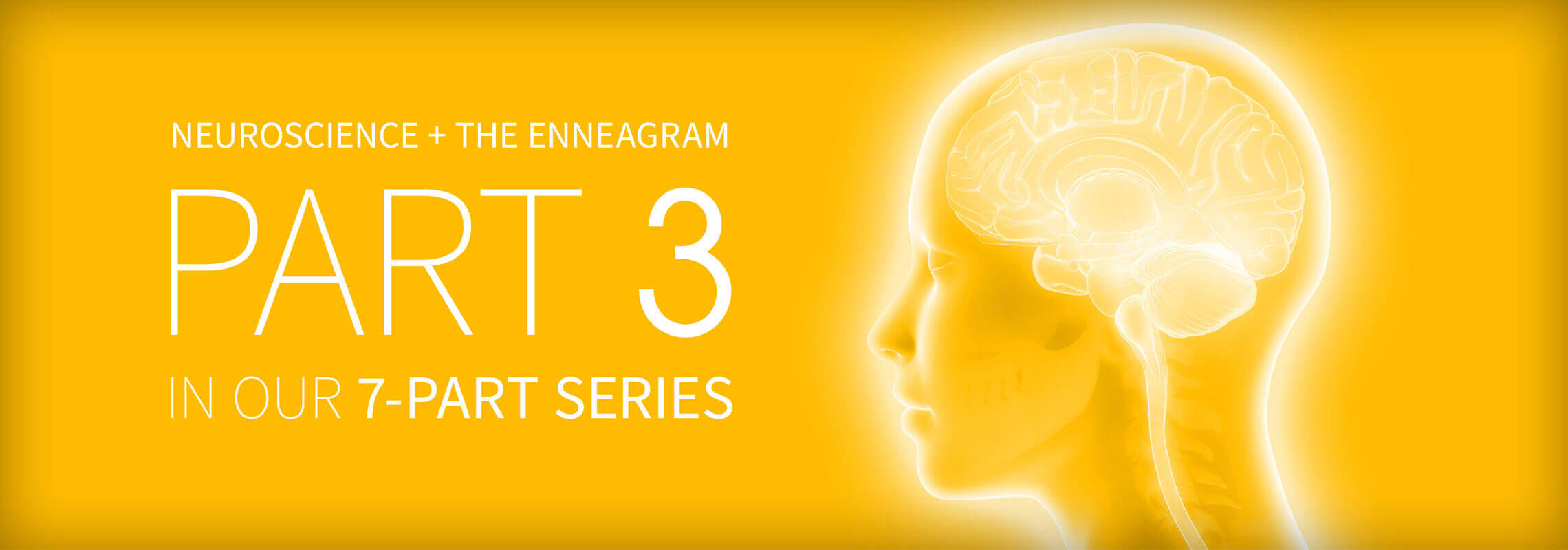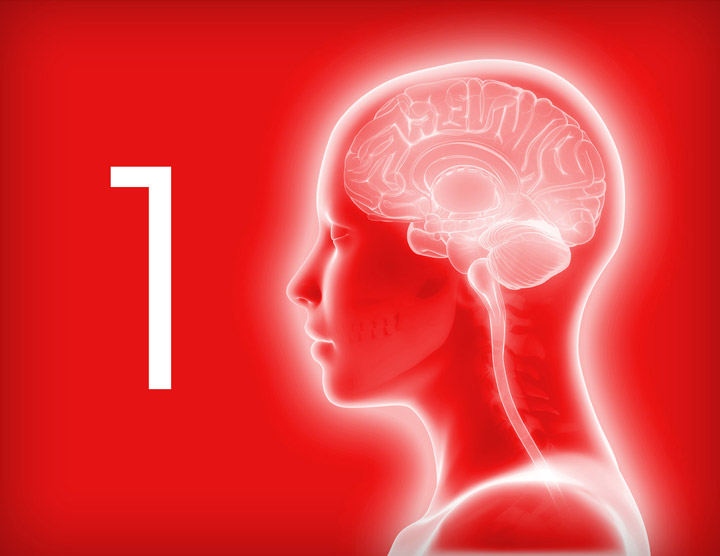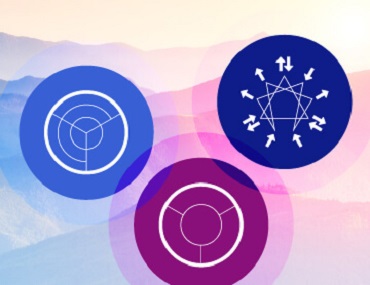Introduction
Early theorists in the Enneagram tradition argued for the existence of three centers, and spoke about the ‘intelligence’ and ‘mindfulness’ of these centers, long before there was any scientific evidence for this. Now, neuroscience has scientifically proven that we have not one, but three brains, which a layman might refer to as the ‘head’, ‘heart’, and ‘gut ’ brains. What do we mean by a ‘brain’ in this context? It merely means that each of these systems has an intrinsic nervous system. And this system includes networks of neurons , enabling them to take in information, process it, store it, and adapt to respond to it . Effectively, they can all perceive, understand, and learn.
In the Enneagram framework, we have identified three centers, namely ‘action’, ‘feeling’, and ‘thinking’. When we start to make the links between the Enneagram and advances in neuroscience, a whole new field of insight opens up to us. Armed with this new scientific evidence of these three centers acting like ‘brains’, we are well-positioned to tap into and harness our full in-born intelligence.
When we integrate our head, heart, and gut intelligence, we maximise and accelerate our development journeys with richness and diversity, accessing our wholeness.
The Enneagram Centers
The Action Center enables the individual to be grounded and alive. As we learn to listen to the sensations in our bodies, we become strongly attuned to our instincts, making things happen in a productive manner. Action energy is hot and relates to:
- Movement, Action, Control, Instinctive responses, Physical sensations
The Feeling Center is associated with the capacity to be open-hearted and enables authentic expression of the self as it is connected to our inner truth. As we open up to the Feeling Center, we become empathetic and attuned to the emotions and needs of the self and the other. Feeling energy is warm and relates to:
- Expression of feelings, Social responsiveness, Emotional self-awareness, Emotional attunement to others, Mediating relationships
The Thinking Center provides us with a quiet, spacious mind that enables greater knowing and consciousness to emerge. Being grounded in this Center’s energy allows us to trust the self and the unfolding of life.recommedfaf People with strong in the Thinking Centers are likely to be objective, analytically astute, detailed orientated, and efficient at planning activities. Thinking energy is cool and relates to:
- Planning, Prioritising, Exploration and analysis of information, Generating ideas and rationality
Enter the science of the three brains, something that Oka believes could hold the key to accessing this higher order of decision-making. But before we arrive at that point, we need to look at something else. How can we possibly claim to have three brains?
“Why are we calling these brains?” says Oka. “We are not calling these brains. Science is calling these brains. There has to be a technical definition of what makes a brain a brain. Your elbow is not a brain. Your kidney is not a brain (as far as we know). But there are lots of good reasons why science can actually show that the head, the heart, and the gut are brains.
They have their own intrinsic nervous systems. They have neurons. They have the whole range of [capabilities] in order to do complex adaptive processes. They can take on information, process it, store it, change and adapt. Essentially, if it can learn, it’s a brain.”
“Through behavioural modelling, we can discover how this applies to life. Low and behold, these different brains do different things.”
New Neuroscientific evidence for the Centers of Intelligence
Neuroscientific research has presented evidence validating the existence of our ‘head’, ‘heart’ and ‘gut’ brains (Soosalu & Oka, 2012). Each of these has their own nervous system, consisting of millions of neurons. These systems have a range of capabilities that can perform complex processes that enable us to adapt to changing environmental demands. These include taking on information, processing it, storing it, changing and adapting it. The section below summarises some of the latest findings validating the existence of our ‘head’, ‘heart’ and ‘gut’ brains. |
Head Brain
The first of these brains is the more obvious one – the head brain that is the master of our mental processes such as thinking, perception, and cognition. The brain consists of more than 100 billion neurons that communicate via connections called synapses. These neurons govern everything from essential functions like breathing, to our ability to create art or poetry. Many specialised areas work together in the brain. The cortex (the outermost layer) is where thinking and voluntary movements begin. The brainstem (between the spinal cord and the rest of the brain) controls basic functions like breathing and sleeping. The basal ganglia (center of the brain) coordinates messages between multiple other brain areas. The cerebellum (at the base and the back of the brain) is responsible for coordination and balance. Other articles in our Resource Library explore the brain and its functions in more depth.
Heart Brain
The human heart, in addition to being our circulatory pump system, also functions as a brain in its own right. The latest research reveals that the heart contains more 40,000 neurons that can sense, feel, learn, and remember (Rajvanshi, 2011).The heart brain consists of a complex intrinsic nervous system, an intricate network of neurons, neurotransmitters, proteins and support cells exactly like those we find in the head. Recent studies have shown that the heart not only sends signals to the brain, but these signals are also ‘obeyed’. The heart brain sends messages to the head brain about how the body feels, but also acts independently to our head brain. Neurons transmit the heart’s signals and its condition to the brain by electrical signals (via the spinal cord and the vagus nerve), but also through chemical reactions.
Gut Brain
We often talk about a ‘gut feeling’ or are told to ‘trust our gut instinct’. This mind-gut connection is not just metaphorical. As it turns out, our brain and gut are connected by an extensive network of neurons and a highway of chemicals and hormones (Sonnenburg & Sonnenburg, 2015). The enteric nervous system functions like a brain, controlling the gastrointestinal system and monitoring the digestive tract. Numerous neurons in the enteric nervous system enable us to ‘feel’ the inner world of our gut. Current cutting-edge research (investigating how the gut brain mediates the body's immune response), tells us that this mass of nerve cells not only partly determines our mental state but also plays a crucial role in controlling certain diseases throughout the body . The field of neuro-gastroenterology has found that psychological and social factors influence the physiology of the gut . It means that stress, depression, or other psychological factors can make the gastrointestinal tract more susceptible to inflammation and infection.
How does this map to the Centers of Intelligence?
With the existence of three brains confirmed, further research not only confirms the Enneagram capabilities around the Centers of Intelligence, but also that each of these Centers has a higher, transformative intelligence that is accessible when we are in a state of flow or mindfulness.
Research by Marvin Oka and Grant Soosalu offers exciting insights into the higher order adaptive capacities of the head, heart and gut brains. Building on the neuroscientific evidence for the existence of three brains, they wanted to explore the practical value of these brains in everyday activities such as intuition, relationships, health, and decision making. Oka and Soosalu conducted various studies using action research and behaviour modelling. The results indicated that each of the neural networks or brains is responsible for processing very specific information associated with its Center of Intelligence. These authors support the idea of wholeness – that we need to use not only our heads, but also the innate intelligence and wisdom of both our heart and gut.
Oka and Soosalu also found that these individual neural networks perform very specific functions, and that there is an adaptive competency associated with each of the brains – a state that represents the highest form of intelligence, or competency, of each of the brains. These competencies serve as a foundation for consistently growing into higher orders of wisdom and ways of being.
The Head Brain is associated with the adaptive competencies of:
- COGNITIVE PERCEPTION: cognition, perception, and pattern recognition
- THINKING: abstraction analysis, synthesis, meta-cognition
- MAKING MEANING: semantic processing, language, narrative, metaphor
- CREATIVITY: collaborative processing, conceiving new possibilities and futures
The Heart Brain is associated with the adaptive competencies of:
- EMOTING: emotional processing of anger, grief, hatred, joy, and happiness
- COMPASSION: emotional connection to humanity and compassion for others
- RELATIONAL AFFECT: our felt connection with others (e.g. love, hate and indifference)
- VALUES: what’s important to us, our aspirations, dreams, desires
The Gut Brain is associated with the adaptive competencies of:
- SELF-PRESERVATION: protecting the self, safety, boundaries, hunger
- MOBILISATION: motility, the impulse for action, ‘gut courage’, and the will to act
- CORE IDENTITY: a deep, visceral sense of self versus not-self
- COURAGE: the impulse to act in the face of the unknown, uncertain or unfamiliar
The authors propose that each of these Intelligences is fundamentally different and has distinct ways of processing information. (It should be noted that the authors suggest that there may not be a single, ideal expression for each brain that is true for everyone in all circumstances. Rather, that these Intelligences are the adaptive foundation to start accessing our full potential.)
Why does this matter?
How are these discoveries relevant to coaching with the Enneagram? Firstly, our clients and we must incorporate all these Centers of Intelligence to make sustainable choices. We may expect, or assume , that the head brain sends messages to the heart and gut, leading operations . However, the research suggests that this is a more complex relationship, with each brain sending information to the others. We need the head intelligence for analysis and the heart intelligence for values and emotional energy . The gut intelligence ensures we pay sufficient attention to risks and have enough willpower to execute decisions even when challenges arise.
Second, we need to use the brain that is most suited to the problem to be solved. Each brain has its unique area of competence, and we should be aware of how much we access each. If we rely on just one source of intelligence for all tasks, we often suffer unintended consequences . When we, for example, use the analytical head brain to design substantial, personal change, we might find that the heart and gut are not fully committed to following the 'agreed' direction.
Third, we need to tap into the wisdom presented in our head, heart and gut brains to benefit from the synergy of using these in a balanced, integrated way. We can access the Intelligences via mindful practice: by being grounded and present in each of these Centers, we open up the intelligence of the Center.
Accessing the full intelligence of the Enneagram Centers
How do we go about accessing the intelligence that each of these Centers brings to our development journey? Is there a preferred order to work with raising the intelligence of the Centers? A sustainable sequence suggested by Oka and Soosalu’s research is:
- Start with the heart. The heart brain gives us the compassion and connection for both ourselves and the other people around us.
- Move to the head. Being prepared by the heart brain to access our values-based emotional states, our head brain’s processing of thoughts, perceptions and interpretation is influenced, anchored and shaped to create authenticity.
- Move back to the heart. Moving back to the heart, equips us with new insights and understanding from the head that are emotionally reinforced and supported, thus giving these a high value. Our compassionate heart provides the desire and emotional fuel to make things better and act in the world.
- Move to the gut. The head and the heart brains’ neural networks then connect to the gut brain, where we assimilate the new idea or way of being, capable of mobilising action. We know that our actions are values-based, coming from heart and head.
- Move back to the heart. Finally, we finish at the heart brain to ensure that our actions are informed and anchored by our values and human connections.
The Centers interact, build on each other and work together. In a coaching environment, we could use these sequences to enable our clients to integrate their Centers and thus invite a more holistic, intelligent approach in problem solving and decision making.
In conclusion
We intuitively have always known that we need to ‘trust our gut’ or ‘follow our heart’. These sayings are based on ancient knowledge that recognises the value of the alternative intelligences that are seated in the human body. The Enneagram described these as three intelligences; Action, Feeling and Thinking Centers.
With the advancement of neuroscience, we are now able to further explore the existence and operation of these Centers of Intelligence. Our three brains all offer a valuable source of information and, with the support of the Enneagram and a trained coach, provide us exciting opportunities to grow into our full potential.
REFERENCES
- Hadzhazy, A. (2010, February 12). Think Twice: How the Gut’s “Second Brain” Influences Mood and Well-Being.
- Rajvanshi, A. (2011, May). The Three Minds of the Body – Brain, Heart and Gut.
- Rozman, D. (2013 February 11). Let Your Heart Talk to Your Brain.
- Sonnenburg, J. and Sonnenburg, E. (2015, May 1). Gut Feelings – the “Second Brain” In Our Gastrointestinal Systems (Excerpt).
- Soosalu, G. and Oka, M. (2012), Neuroscience and the Three Brains of Leadership. Retrieved from

 What is the Enneagram?
What is the Enneagram?
 Introduction to the 27 Subtypes
Introduction to the 27 Subtypes
 Introduction to the 3 Centers
Introduction to the 3 Centers
 Wings
Wings
 Lines and Integration
Lines and Integration
 Enneagram History & Origin
Enneagram History & Origin
 Enneagram for Myself
Enneagram for Myself
 Enneagram for Practitioners
Enneagram for Practitioners
 Enneagram for Business
Enneagram for Business
 iEQ9 Individual Reports
iEQ9 Individual Reports
 iEQ9 Team Reports
iEQ9 Team Reports
 iEQ9 Questionnaire
iEQ9 Questionnaire
 Training Events
Training Events
 Level 1 iEQ9 Accreditation
Level 1 iEQ9 Accreditation
 Level 2 Enneagram Team Dynamics
Level 2 Enneagram Team Dynamics
 International Enneagram Conference
International Enneagram Conference
 iEQ9 Community of Practice Events
iEQ9 Community of Practice Events
 About Integrative9
About Integrative9
 Meet the Faculty
Meet the Faculty
 Testimonials
Testimonials
 Contact Us
Contact Us



